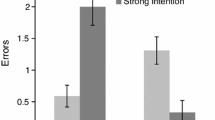Abstract
An experiment was done to examine the control heuristic perspective on illusory control and the effects of motives on control judgments, using a computer task similar to the “light onset” task used in previous research. Desire for the outcome and reinforcement were manipulated. As predicted from a control heuristic perspective, the effect of level of reinforcement on judgments of personal control was mediated by the measure of perceived connection: the perception of the number of positive confirming cases. Motives increased illusions of control, but only in the high reinforcement condition. A mediational analysis that examined how motives affect control judgments found that when the motive to get the outcomes was high, participants had higher estimates of having acted intentionally and these estimates partially mediated the relationship between the motivation manipulation and judgments of control. It appears that perceptions of connection mediate the relationship between reinforcement and illusory control, while judgments of intentionality partially mediate the effect of motives for control and illusory control.
Similar content being viewed by others
References
Ajzen, I., & Fishbein, M. (1969). The prediction of behavioral intentions in a choice situation. Journal of Experimental Social Psychology, 5, 400–416.
Alloy, L. B., & Abramson, L. Y. (1979). Judgment of contingency in depressed and nondepressed students: Sadder but wiser? Journal of Experimental Psychology: General, 108, 441–485.
Arkes, H. R., & Harkness, A. R. (1983). Estimates of contingency between two dichotomous variables. Journal of Experimental Psychology: General, 112, 117–135.
Baron, R. M., & Kenny, D. A. (1986). The moderator–mediator distinction in social psychological research: Conceptual, strategic, and statistical considerations. Journal of Personality and Social Psychology, 51, 1173–1182.
Behling, O., & Starke, F. A. (1973). The postulates of expectancy theory. Academy of Management Journal, 16, 373–388.
Biner, P. M., Angle, S. T., Park, J. H., Mellinger, A. E., & Barber, B. C. (1995). Need and the illusion of control. Personality and Social Psychology Bulletin, 21, 899–907.
Biner, P. M., Huffman, M. L., Curran, M. A., & Long, K. R. (1998). Illusory control as a function of motivation for a specific outcome in a chance-based situation. Motivation and Emotion, 22, 277–291.
Budescu, D. V., & Bruderman, M. (1995). The relationship between the illusion of control and the desirability bias. Journal of Behavioral Decision Making, 8, 109–125.
Cedrus, Co. (1998). Superlab pro for windows. San Pedro, CA: Author.
Horswill, M. S., & McKenna, F. P. (1999). The effect of perceived control on risk taking. Journal of Applied Social Psychology, 29, 377–391.
Irwin, F. W. (1953). Stated expectations as functions of probability and desirability of outcomes. Journal of Personality, 21, 329–335.
Irwin, F. W., & Metzger, M. J. (1967). Effects of independent outcome-values of past events upon subsequent choices. Psychonomic Science, 9, 613–614.
Irwin, F. W., & Snodgrass, J. G. (1966). Effects of independent and dependent outcome values upon sets. Journal of Experimental Psychology, 71, 282–285.
Kruglanski, A. W. (1996). Motivated social cognition: Principles of the interface. In E. T. Higgins & A. W. Kruglanski (Eds.), Social psychology: Handbook of basic principles (pp. 493–520). New York: Guilford.
Kunda, Z. (1990). The case for motivated reasoning. Psychological Bulletin, 108, 480–498.
Langer, E. J. (1975). The illusion of control. Journal of Personality and Social Psychology, 32, 311–328.
Langer, E. J. (1977). The psychology of chance. Journal for the Theory of Social Behaviour, 7, 185–207.
Nasco, S. A., & Marsh, K. L. (1999). Gaining control through counterfactual thinking. Personality and Social Psychology Bulletin, 25, 556–568.
Nickerson, R. S. (1998). Confirmation bias: A ubiquitous phenomenon in many guises. Review of General Psychology, 2, 175–220.
Preacher, K. J., & Leonardelli, G. J. (2004). Calculation for the Sobel test. An interactive calculation tool for mediation tests. Retrieved from http://www.unc.edu/preacher/sobel/sobel.htm.
Pyszczynski, T., & Greenberg, J. (1987). Toward an integration of cognitive and motivational perspectives on social inference: A biased hypothesis-testing model. In L. Berkowitz (Ed.), Advances in experimental social psychology (Vol. 20, pp. 297–340). New York: Academic.
Rotter, J. B. (1954). Social learning and clinical psychology. New York: Prentice-Hall.
Sobel, M. E. (1982). Asymptotic confidence intervals for indirect effects in structural equation models. In S. Leinhardt (Ed.), Sociological methodology 1982 (pp. 290–312). Washington, DC: American Sociological Association.
Taylor, S. E., & Brown, J. D. (1988). Illusion and well-being: A social psychological perspective on mental health. Psychological Bulletin, 103, 193–210.
Thompson, S. C., Armstrong, W., & Thomas, C. (1998). Illusions of control, underestimations, and accuracy: A control heuristic explanation. Psychological Bulletin, 123, 143–161.
Thompson, S. C., Kent, D., Thomas, C., & Vrungos, S. (1999). Real and illusory control over exposure to HIV in college students and gay men. Journal of Applied Social Psychology, 29, 1128–1150.
Thompson, S. C., & Spacapan, S. (1991). Perceptions of control in vulnerable populations. Journal of Social Issues, 47(4), 1–21.
Vroom, V. H. (1964). Work and motivation. New York: Wiley.
Author information
Authors and Affiliations
Corresponding author
Rights and permissions
About this article
Cite this article
Thompson, S.C., Kyle, D., Osgood, A. et al. Illusory Control and Motives for Control: The Role of Connection and Intentionality. Motiv Emot 28, 315–330 (2004). https://doi.org/10.1007/s11031-004-2386-0
Issue Date:
DOI: https://doi.org/10.1007/s11031-004-2386-0




